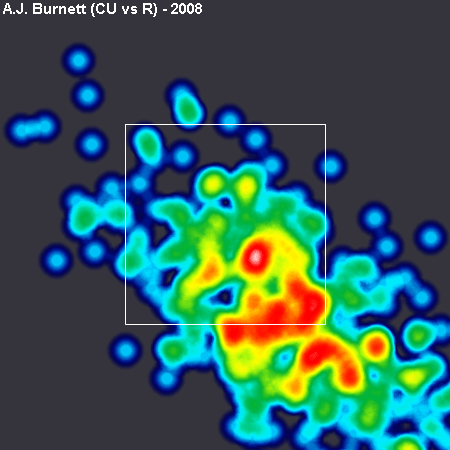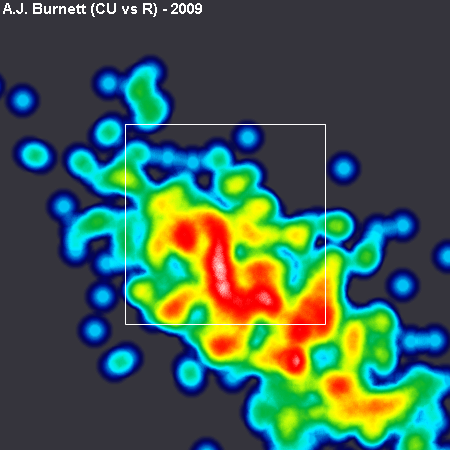A.J. Burnett has hopes up this spring. He’s turned in solid performances on the mound, and new pitching coach Larry Rothschild has helped him make some mechanical changes. As a result, many are cautiously optimistic that Burnett will bounce back in 2011 after a horrific 2010 campaign. The Yankees could use an effective Burnett, that’s for certain. Yet, fans would have to be forgiven for not holding their breath. Like a zit, Bad A.J. seems to show up whenever he pleases, with no warning, often at a rather inconvenient time.
So what are the signs that Burnett is turning over a new leaf this year? What are the indications that Burnett’s improvement is the result of changes he’s made, and not luck on batted balls in play or because he’s facing a weak lineup? Part of the answer lies in the quality of Burnett’s moneymaker: his curveball. When Burnett has his curveball working in tandem with his fastball, he becomes a very difficult pitcher for batters to handle. It’s why he’s so tantalizing and it’s why people refer to his “electric stuff” (as annoying as that gets) and say that he has the ability to throw a no-hitter every time he steps on the mound. When he’s on he is on, and vaya con Dios to the opposing team: you’ll need it.
There’s been a wealth of Burnett analysis amongst Yankee blogs in the past few weeks. Jason at IIATMS analyzed his fastball velocity and heat maps in different counts, concluding that Burnett becomes more ineffective in two-strike counts. Larry Koestler over at Yankee Analysts used Pitch F(x) to analyze Burnett’s repetoire on a month-by-month basis, concluding that Burnett’s curveball command completely abandoned him in 2010. Finally, Mike previewed Burnett last week, and said that he was cautiously optimistic and expected better results with the curveball. He also noted that Burnett’s curveball went from the best in the game (using Fangraphs’ Pitch Type Values) to a below-average pitch in one offseason. While the Pitch Type Values metric has clear limitations, most observers would likely agree that Burnett’s typically deadly curveball was subpar in 2010. Utilizing Fangraphs’ awesome Heat Map tool, we can see just how different it really was, and learn what to look for this year.
Curveball to lefties
The first thing to keep in mind is that these charts are from the perspective of the catcher. So left-handed batters are on your right, and right-handed batters are on your left. It’s confusing, so simply think of yourself as Jesus Montero back there. Feel better?

Burnett had a fantastic 2008, throwing 221.1 innings of 3.40 FIP ball with a 9.39 K/9 and a 3.50 BB/9. This graph shows us a real gathering around two different locations. Burnett was dropping his curveball on the outer half of the plate in the strikezone, and was burying it on the inside corner low and out of the strike zone. These are really two different kinds of curveballs in terms of their function. The former is a pitch Burnett drops in the zone for a strike. Anecdotally, it seems to me that this is a pitch batters usually take for a strike, rather than swing through. The latter is a pitch Burnett likes to bury outside of the zone, sometimes burying it in the middle of the plate down in the dirt, and other times seeming aiming it at the batter’s back (left) foot. The latter pitch often has more horizontal break, meaning it’s moving right to left. You can see the former pitch in action in this video at the 0:48 mark, and the later at the 1:21 mark. In sum, the above chart is what AJ Burnett’s curveball chart should look like.

In 2009 we see less of the “down and in” curveball and more of the curveball placed on the outer half of the plate. The 2008 and 2009 charts are fairly similar visually, although the 2009 scatter is more stretched out horizontally. The 2008 chart is more clustered around the strikezone.

In 2010 it’s easy to see a distinct lack of command of the curveball to lefties, a real failure to keep it in the strikezone. He doesn’t show the same ability to center the pitch on the lower outer half of the plate, and he’s throwing what seems to be just as many curveballs out of the zone as he is inside the zone. If a pitcher can’t convince you that the next pitch is going to be a strike, then you’re not going to swing. It’s very simple. Further it seems, again anecdotally, that when Burnett would miss with his curveball he would miss badly. The red dot at the very bottom of the image would confirm this observation.
Curveballs to righties

Very simply, this is a deadly pitch. By and large, Burnett’s was throwing his curveball in 2008 nearly exclusively on the lower, outer edge of the plate. The largest red spot straddles the strike zone line, meaning that it was a 50/50 proposition as to whether the pitch would be called for a strike and making it very difficult for batters to lay off. Burnett also dropped a fair amount of curves in the middle of the zone, and then further out of the zone and down and away. The important thing was being able to command it in the zone, and also having the ability to leave it out of the zone in the attempt to get batters to chase the pitch.

There’s a distinct difference in the 2009 heat map from the 2008 heat map. In this year, Burnett threw far more curveballs in the middle of the plate, but in the lower half of the zone. He also continued his trend of dropping them in on the lower outer edge of the plate and throwing some lower and out of the zone, but the trend in 2009 seemed to be to throw more curveballs towards the center of the strike zone.

To righties in 2010 we see Burnett leaving a good amount in the lower inner quadrant, as well as directly in the middle of the plate.Burnett is dispersing these curveballs throughout the zone, but clearly shows a problem commanding them in the strikezone. Like curveballs to lefties in 2010, Burnett’s ability to throw the pitch for a strike seemed to abandon him in 2010.
Like many analysts, I’m optimistic that Burnett can bounce back in 2010. There are good reasons to hope for a bounceback, reasons not based solely on the irrational optimism that Spring Training brings to most fans (myself included). Burnett has a new pitching coach, and the new mechanical changes appear to simplify his delivery. If he’s able to recover command of his curveball, Burnett could be a much improved pitcher in 2011. Given the state of the Yankee rotation and the $49.5M he’s due over the next three years, this would surely be a welcome development.
Leave a Reply
You must be logged in to post a comment.